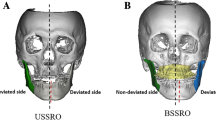Abstract
Objective
The aim of this study was to evaluate alterations in condylar positioning through submentovertex projection (Hirtz Radiographic Technique) in patients who underwent orthognathic surgery for maxillary advancement and mandibular setback with stable internal fixation.
Methods
A prospective longitudinal clinical study of 40 surgical patients presenting dentofacial deformity admitted in the Oral and Maxillofacial Surgery Department of Federal University of Paraná (UFPR) in the period between March 2013 and December 2015. We performed two submentovertex digital radiographs, one 7 days before surgery and the other one 30 days after the procedure. Cephalometric tracings were made using Radiocef® Studio 2 Software and measured the intercondylar and condylar angles (right and left).
Results
There was a decrease in the intercondylar angle (p < 0.001) and an increase in condylar angles both the right and the left side (p < 0.001) when compared with the pre and postoperative period. There was a larger increase in condylar angle on the right side in males (p = 0.007).
Conclusion
There is a tendency of decreasing of the intercondylar angle after orthognathic surgery, regardless of the alteration in the condylar angles, creating a new position of the condyle in the glenoid fossa. Patients with asymmetry may present greater alterations in the positioning of the opposite condylar to the deviation of the mandibular midline.





Similar content being viewed by others
References
Bettega G, Dessene V, Raphael B, Cinquin P (1996) Computer-assisted mandibular condyle positioning in orthognathic surgery. J Oral Maxillofac Surg 54:553–558
Harris MD, Van Sickels JR, Alder M (1999) Factors influencing condylar position after the bilateral sagittal slit osteotomy fixed with bicortical screws. J Oral Maxillofac Surg 57(6):650–654
Bettega G, Cinquin P, Lebeau J, RAaphael B (2002) Computer-assisted orthognathic surgery: clinical evaluation of a mandibular condyle repositioning system. J Oral Maxillofac Surg 60:27–34
Bell WH, Schendel SA (1977) Biologic basis for modification of the sagittal ramus split operation. J Oral Surg 35:362–369
Leonard M (1976) Preventing rotation of the proximal fragment in the sagittal ramus split operation. J Oral Surg 34:942
EllisIII E (1994) Condylar positioning devices for orthognathic surgery: are they necessary? J Oral Maxillofac Surg 52(6):536–552
Gerressen M, Stockbrink G, Smeets R, Riediger D, Ghassemi A (2007) Skeletal stability following bilateral sagittal split osteotomy (BSSO) with and without condylar positioning device. J Oral Maxillofac Surg 65:1297–1302
Costa F, Robiony M, Toro C, Sembronio S, Polini F, Politi M (2008) Condylar positioning devices for orthognathic surgery: a literature review. Oral Surg Oral Med Oral Pathol Oral Radiol Endod 106:179–190
Ueki K, Nakagawa K, Takatsuka S, Yamamoto E (2001) Plate fixation after mandibular osteotomy. Int J Oral Maxillofac Surg 30:490–496
Cortez ALV, Passeri LA (2007) Position after Le Fort I osteotomy in patients with asymptomatic temporomandibular joints: a prospective study. J Oral Maxillofac Surg 65:237–241
Nishimura SS, Iwase M, Nagumo M (1997) Positional changes in the mandibular condyle and amount of mouth opening after sagittal split ramus osteotomy with rigid or nonrigid osteosynthesis. J Oral Maxillofac Surg 55:672–676
Kim YJ, Oh KM, Hong JS, Lee JH, Kim HM, Reyes M, Cevidanes LH, Park YH (2012) Condylar positioning after jaw surgery. J Oral Maxillofac Surg 70:2143–2152
Baek SH, Kim TK, Kim MJ (2006) Is there any difference in the condylar position and angulation after asymmetric mandibular setback? Oral Surg Oral Med Oral Pathol Oral Radiol Endod 101:155
Lee W, Park JU (2002) Three-dimensional evaluation of positional change of the condyle after mandibular setback by means of bilateral sagittal split ramus osteotomy. Oral Surg Oral Med Oral Pathol Oral Radiol Endod 94:305
Choi B-J, Choi Y-H, Lee B-S, Kwon Y-D, Choo Y-J, Ohe J-Y (2014) A CBCT study on positional change in mandibular condyle according to metallic anchorage methods in skeletal class III patients after orthognathic surgery. J Craniomaxillofac Surg 42:1617–1622
Ueki K, Yoshizawa K, Moroi A, Iguchi R, Kosaka A, Ikawa H, Saida Y, Hotta A, Tsutsui T (2015) Changes in computed tomography values of mandibular condyle and temporomandibular joint disc position after sagittal split ramus osteotomy. J Craniomaxillofac Surg 43:1208–1217
Lee BR, Kang DK, Son WS (2011) The relationship between condyle position morphology and chin deviation in skeletal class III patients with facial asymmetry using cone-beam CT. Korean J Orthod 41:87
Funding
There was no source of support in the form of grants.
Author information
Authors and Affiliations
Corresponding author
Ethics declarations
Conflict of interest
The authors declare that they have no conflict of interest.
Ethical approval
All procedures performed in studies involving human participants were in accordance with the ethical standards of the institutional and/or national research committee and with the 1964 Helsinki Declaration and its later amendments or comparable ethical standards.
Informed consent
Informed consent was obtained from all individual participants included in the study.
Rights and permissions
About this article
Cite this article
da Silva Félix Junior, W., Klüppel, L.E., da Costa, D.J. et al. Radiographic evaluation of condylar positioning in patients undergoing orthognathic surgery. Oral Maxillofac Surg 21, 419–423 (2017). https://doi.org/10.1007/s10006-017-0649-7
Received:
Accepted:
Published:
Issue Date:
DOI: https://doi.org/10.1007/s10006-017-0649-7




